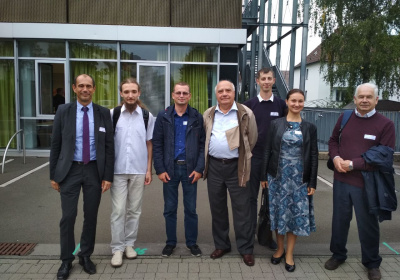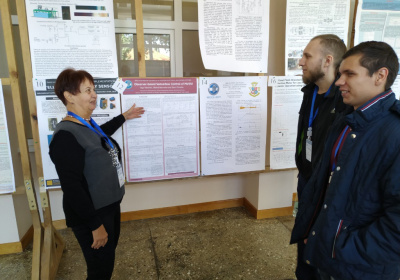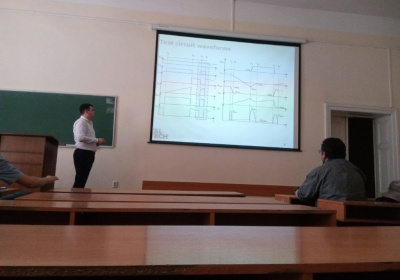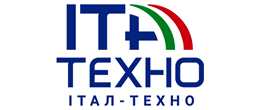Areas of research
Field oriented control system for induction motors
The department has developed the field oriented control algorithms for induction motors (IM), which provide increased quality control and energy efficiency of electromechanical energy conversion.
The algorithms with angular velocity sensor provide global exponential tracking of linkage vector module and mechanical coordinates (torque, angular velocity, position). Also they have properties of robustness to parameter perturbations of IM. A number of solutions adaptive to active resistance of a stator and a rotor have been found. By using the systems with variable structure, the algorithm with the properties of invariance to variations of active resistance of a rotor circuit has been developed.
Sensorless field oriented control algorithms provide local exponential tracking of rotor flux vector module and mechanical coordinates. The quality achieved in the developed sensorless field oriented control systems is close to the existing one in angular velocity measuring systems. The achievable range of angular velocity regulation is about 1:100.
All theoretical solutions have been tested experimentally for installations up to 200 kW with the implementation of field oriented control structures for digital signal processors.
Areas of development: consideration of saturation, operation in the mode of profound weakening the field, consideration and qualitative compensation of inverter imperfections in sensorless control systems, increasing robustness, adaptive control.
Field oriented control systems with maximizing torque per ampere ratio
Field oriented control algorithms for induction motors with maximizing torque per ampere ratio (MaximizationTorque per Ampere – MTA) and considering the saturation of a magnetic circuit have been developed/ These algorythms provide:
– higher torque of a motor while limiting the current of an inverter or a primary source of electric power;
– greater energy efficiency as a criterion MTA is close to that of minimum active losses;
– possibility of implementing energy saving function “stop & go”, which is the most efficient in transport applications.
The effectiveness of the developed algorithms is confirmed experimentally while using 0.75-50 kW motors.
Areas of development: operation in the mode of weakening the field, regulation of angular position of MTA, implementation on an actual vehicle, MTA – control without measuring mechanical coordinates.
Electromechanical systems based on double fed induction machine
The standard configuration of an electromechanical system with a double fed induction machine (DFIM) involves connecting stator of a wound-rotor induction motor to the grid , while a semiconductor converter is connected to a rotor circuit and it is used for control the coordinates of system.
At present, the following DFIM algorithms are developed and experimentally investigated (implemented):
– algorithms to start and synchronize DFIM with the grid;
– algorithms of vector control of coordinates in drive mode;
– algorithms of controlling a generator when working on the grid;
– algorithms of controlling an autonomous generator;
Areas of development: sensorless control of DFIM, robust and adaptive control.
Induction motor parameter identification
A number of algorithms to identify electrical parameters of an induction motor, which ensure their asymptotic evaluation while using special test signals, have been developed. The amount of time required for this identification is much smaller than the mass-produced products of known manufacturers. The algorithms are tested experimentally with low-power machines.
Areas of development: procedures for designing test signals, consideration of IM saturation, and inverter imperfections.
Controlling active rectifiers
The algorithms to control active rectifiers (for IGBT), which provide voltage stabilization in DC part and regulate power factor at a given level, have been developed. Experimental tracking as the part of FOC system with 2.2 kW motor has been conducted.
Areas of development: optimization of parameters to reduce costs.
Controlling parallel active filters
A parallel active filter is designed to compensate for harmonic current distortion in the network created by non-linear loads such as electric semiconductor converters, impulse power supply, arc furnaces etc.
The algorithms in real-time evaluation of harmonic current as well as algorithms to stabilize the voltage capacity of DC part and algorithms to adjust filter current have been developed. Existing developments are investigated through mathematical modeling and partly in an experimental way.
Areas of development: practical implementation and experimental testing a parallel active filter.
Unified controllers and scope of their implementation
We have developed a number of standardized digital controllers based on digital signal processors Texas Instruments (TMS320F28335, TMS320F28069 and others made earlier), by means of which practical realization and implementation of control structures developed at the Department are made.
Implementation of the results is carried out:
– commercially in a traction electric drive of a tram (100 kW);
– commercially in electromechanical systems of the process industry (15 – 200 kW);
– commercially in power generation systems for wind turbines;
– in an industrial design of traction electric drive of a trolleybus;
– in water recycling station by implementing an electric drive with double fed induction machine (750 kW);
Other areas of interest
In addition, there are a lot of developments related to controlling synchronous motors, DC motors, and linear induction motors. We are also interested in electromechanical systems with new types of electric machines, systems with complex mechanics, electric transport, electric cars and other objects when standard solutions do not work.

Internship in Warwick, 5-year m.stud.
Тег «Далее»

Workshop-seminar in THM
Тег «Далее»

IEEE 2-nd conference MEES’19
Тег «Далее»

Collaboration in Small Academy of Sciences works
Тег «Далее»

2-nd conference IEEE UkrCon’19
Тег «Далее»

Project in THM (DAAD scholarship)
Тег «Далее»











